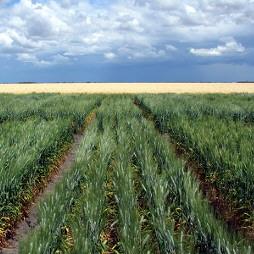Posted 12 March 2012

Salt-tolerant durum wheat grown in northern New South Wales as part of a field trial. (Photo: CSIRO).
A team of Australian scientists involving the University of Adelaide has bred salt tolerance into a variety of durum wheat that shows improved grain yield by 25% on salty soils.
Using 'non-GM' crop breeding techniques, scientists from CSIRO Plant Industry have introduced a salt-tolerant gene into a commercial durum wheat, with spectacular results shown in field tests. Researchers at the University of Adelaide's Waite Research Institute have led the effort to understand how the gene delivers salinity tolerance to the plants.
The research is the first of its kind in the world to fully describe the improvement in salt tolerance of an agricultural crop - from understanding the function of the salt-tolerant genes in the lab, to demonstrating increased grain yields in the field.
The results are published today in the journal Nature Biotechnology. The paper's senior author is Dr Matthew Gilliham from the University's Waite Research Institute and the ARC Centre of Excellence in Plant Energy Biology. Lead authors are CSIRO Plant Industry scientists Dr Rana Munns and Dr Richard James and University of Adelaide student Bo Xu.
"This work is significant as salinity already affects over 20% of the world's agricultural soils, and salinity poses an increasing threat to food production due to climate change," Dr Munns says.
Dr Gilliham says: "Salinity is a particular issue in the prime wheat-growing areas of Australia, the world's second-largest wheat exporter after the United States. With global population estimated to reach nine billion by 2050, and the demand for food expected to rise by 100% in this time, salt-tolerant crops will be an important tool to ensure future food security."
Domestication and breeding has narrowed the gene pool of modern wheat, leaving it susceptible to environmental stress. Durum wheat, used for making such food products as pasta and couscous, is particularly susceptible to soil salinity.
However, the authors of this study realised that wild relatives of modern-day wheat remain a significant source of genes for a range of traits, including salinity tolerance. They discovered the new salt-tolerant gene in an ancestral cousin of modern-day wheat, Triticum monococcum.
"Salty soils are a major problem because if sodium starts to build up in the leaves it will affect important processes such as photosynthesis, which is critical to the plant's success," Dr Gilliham says.
"The salt-tolerant gene (known as TmHKT1;5-A) works by excluding sodium from the leaves. It produces a protein that removes the sodium from the cells lining the xylem, which are the 'pipes' plants use to move water from their roots to their leaves," he says.
Dr James, who led the field trials, says: "While most studies only look at performance under controlled conditions in a laboratory or greenhouse, this is the first study to confirm that the salt-tolerant gene increases yields on a farm with saline soils.
Field trials were conducted at a variety of sites across Australia, including a commercial farm in northern New South Wales.
"Importantly, there was no yield penalty with this gene," Dr James says.
"Under standard conditions, the wheat containing the salt-tolerance gene performed the same in the field as durum that did not have the gene. But under salty conditions, it outperformed its durum wheat parent, with increased yields of up to 25%.
"This is very important for farmers, because it means they would only need to plant one type of seed in a paddock that may have some salty sections," Dr James says.
"The salt-tolerant wheat will now be used by the Australian Durum Wheat Improvement Program (ADWIP) to assess its impact by incorporating this into recently developed varieties as a breeding line."
Dr Munns says new varieties of salt-tolerant durum wheat could be a commercial reality in the near future.
"Although we have used molecular techniques to characterise and understand the salt-tolerant gene, the gene was introduced into the durum wheat through 'non-GM' breeding processes. This means we have produced a novel durum wheat that is not classified as transgenic, or 'GM', and can therefore be planted without restriction," she says.
The researchers are taking their work a step further and have now crossed the salt-tolerance gene into bread wheat. This is currently being assessed under field conditions.
Source: The University of Adelaide Media Release
Links

Professor Andy Baker features in American Water Resources Association ‘Water Resources Impact’, September 2020 edition.

The Connected Waters Initiative (CWI) is pleased to welcome Taylor Coyne to its network as a postgraduate researcher. If you’re engaged in research at a postgraduate level, and you’re interested in joining the CWI network, get in touch! The CWI network includes multidisciplinary researchers across the Schools of Engineering, Sciences, Humanities and Languages and Law.

The Grand Challenge on Rapid Urbanisation will establish Think Deep Australia, led by Dr Marilu Melo Zurita, to explore how we can use our urban underground spaces for community benefit.

On the 21 August 2020, CWI researchers made a submission to the National Water Reform Inquiry, identifying priority areas and making a number of recommendations as to how to achieve a sustainable groundwater future for Australia.

Results published from a research project between the Land Development Department (LDD) Thailand and UNSW has demonstrated how 2-dimensional mapping can be used to understand soil salinity adjacent to a earthen canal in north east Thailand (Khongnawang et al. 2020).